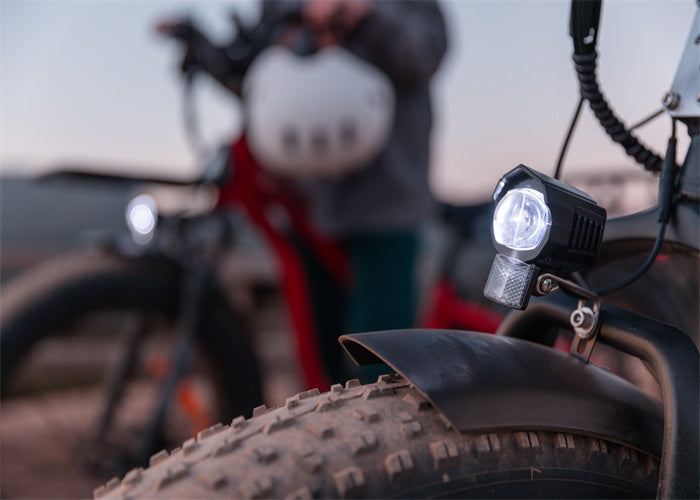Have you been shopping for a bike and come across the “700C wheel” option? Wondering what exactly this feature is and how it impacts the size of the bike?
And by the way, if you're thinking about upgrading your ride, check out Tesway for some of the best budget electric bikes around.

Origin and Evolution of 700c Wheel
The term "700c" often gets mixed up with "700cc," which is totally unrelated.
While 700cc refers to the engine displacement in motorcycles, 700c is all about bicycle tires. Specifically, in the old French sizing system, the "700" stands for the tire's diameter, and the "c" indicates the width.
But here’s the kicker: the diameter isn’t 700 millimeters; it’s actually 633 millimeters.
This designation has historical roots dating back to the early days of cycling in France.
The French system categorized tires into several sizes from "a" to "d", with "a" being the narrowest and "d" the widest.
Over time, most of these categories became obsolete, but the 700c size endured due to its versatility and widespread use.
It's crucial for modern cyclists to understand that the "c" in 700c doesn't relate to centimeters but is part of this legacy classification system.
SEE ALSO : Why Choose a fat tire electric bike 750 watt?
700c Wheels vs. 29-Inch Tires
Another common mix-up is thinking 700c and 29-inch tires are the same. While they do share the same diameter, the 700c tires are narrower than their 29-inch counterparts.
So, if you try to fit a 29-inch tire on a 700c rim, it’s not going to work out.
Both 700c and 29-inch wheels have a diameter of approximately 622 millimeters, but their applications and characteristics differ.
29-inch wheels, often used in mountain biking, are typically paired with wider tires that provide better grip and stability on rough terrains.
In contrast, 700c wheels are common in road biking and hybrid bikes, favored for their ability to maintain high speeds and efficiency on paved surfaces.
Is 700c Equal To 26 Inches
Let’s get straight to it: 700c is not equal to 26 inches. The 26-inch tire is a whole different ball game.
When you put them side by side, the 700c wheel is larger in diameter than the 26-inch one. The 700c wheel measures about 27.5 inches in diameter, which is noticeably bigger than a 26-inch wheel.
The confusion usually comes from the different systems used for measuring. The 700c follows the French system, while the 26-inch measurement is from the English system.
Knowing these differences helps you pick the right tire size for your bike, ensuring everything fits perfectly and performs well.
26-inch wheels are often used in older mountain bikes and some recreational bikes.
They are generally more robust and suitable for rugged terrains, making them a favorite for off-road adventures.
700c wheels are designed for speed and efficiency on smoother surfaces, providing a lighter and more responsive ride.
What Size Is A 700c Wheel In Inches
In inches, a 700c wheel is about 27.5 inches in diameter. This size places it nicely between the standard 26-inch and the 29-inch mountain bike tires.
The 27.5-inch size gives you a sweet spot of stability, speed, and handling, making it a go-to for road bikes, hybrids, and even some mountain bikes.
When you’re converting tire sizes, always consider both the diameter and the width to make sure you’re getting the right fit.
The versatility of the 27.5-inch size means it strikes a balance between the nimble handling of smaller wheels and the rolling efficiency of larger ones, making it a popular choice for a wide range of cycling disciplines.
How Wide Of A Tire Can You Fit On A 700c
For a 700c rim, you can typically fit tires ranging from 28mm to 35mm in width. If you’re into road biking and speed is your thing, go for the narrower tires around 28mm.
They have less rolling resistance, perfect for smooth pavements.
If you prefer a bit more comfort and grip, especially on rougher terrains or gravel paths, wider tires up to 35mm are your friends.
They offer better stability and cushioning, making your ride more comfortable. It's essential to match the tire width with your riding conditions and style.
Wider tires can handle lower air pressure, which enhances grip and shock absorption, crucial for rough or uneven surfaces.
Practical Applications Of 700c Wheels
These wheels are predominantly found on road bikes, touring bikes, and hybrids. Their design optimizes for smooth, paved surfaces, allowing cyclists to achieve higher speeds with less effort.
The narrower tire profile reduces rolling resistance, making 700c wheels ideal for long-distance cycling and commuting.
Touring cyclists appreciate 700c wheels for their ability to carry heavier loads without compromising speed.
Conclusion
Road bikes equipped with 700c wheels are perfect for competitive cyclists and those who prioritize speed and efficiency.
For urban commuters, hybrids with 700c wheels offer a comfortable and versatile ride, blending the characteristics of road and mountain bikes.
FAQs
Are 700c wheels good for touring?
Yes, 700c wheels are commonly used in touring bikes for their ability to maintain speed and efficiency on paved roads, making them ideal for long-distance cycling.
What are the advantages of 700c wheels over 26-inch wheels?
700c wheels offer a larger diameter (approximately 27.5 inches) compared to 26-inch wheels, providing better rolling efficiency and suitability for road and hybrid bikes.
Can I convert a bike from 26-inch to 700c wheels?
Converting from 26-inch to 700c wheels may require changes in brake and frame compatibility due to differences in wheel size and diameter.












Share:
Is 20mph Enough for Ebikes, or Do They Need to Go Faster?
Dilemma | Replace Battery or New Electric Bike?